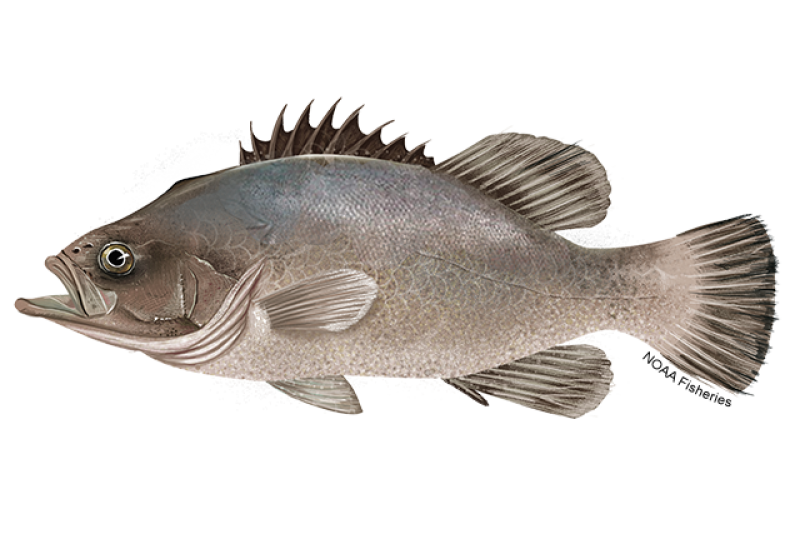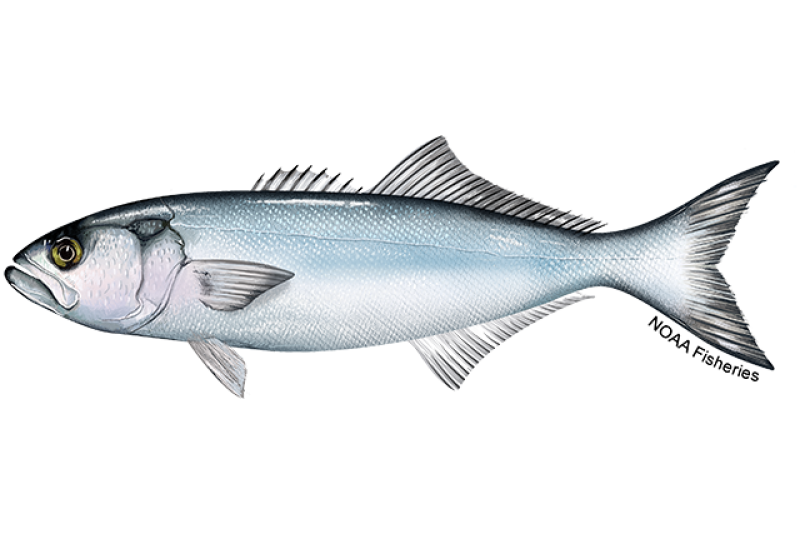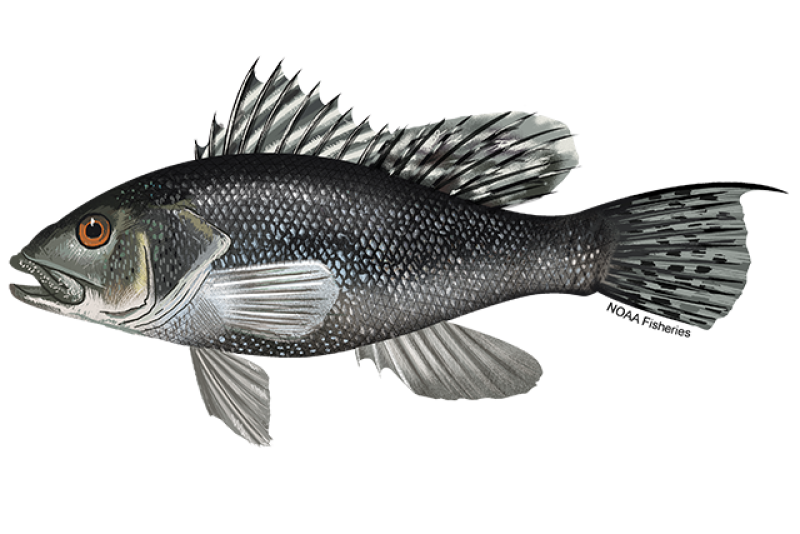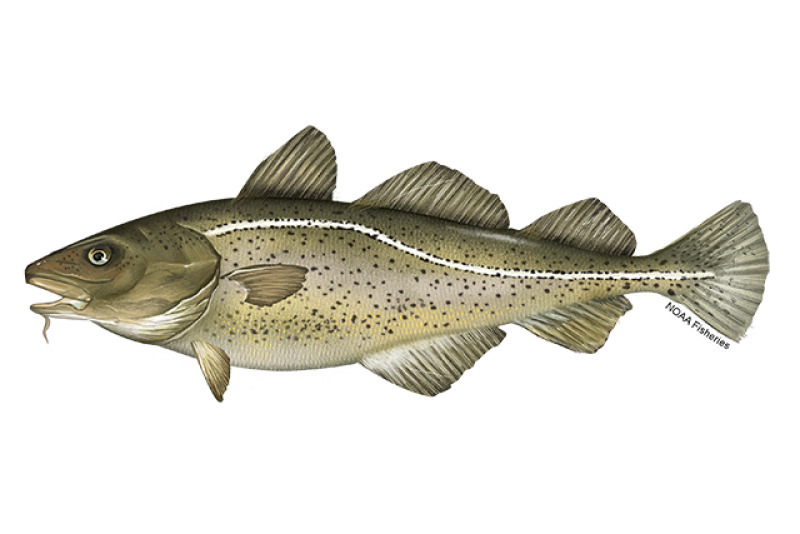 Atlantic striped bass. Credit: NOAA Fisheries
Atlantic striped bass. Credit: NOAA Fisheries
Atlantic striped bass. Credit: NOAA Fisheries
About the Species
 Atlantic striped bass. Credit: NOAA Fisheries
Atlantic striped bass. Credit: NOAA Fisheries
Atlantic striped bass. Credit: NOAA Fisheries
U.S. wild-caught Atlantic striped bass is a smart seafood choice because it is sustainably managed and responsibly harvested under U.S. regulations.

Population
The stock is overfished, but the fishing rate established under a rebuilding plan promotes population growth.

Fishing Rate
Not subject to overfishing.

Habitat Impact
Fishing gears used to harvest striped bass have minimal impacts on habitat.

Bycatch
Regulations are in place to minimize bycatch.
Population Status
- According to the 2024 stock assessment, Atlantic striped bass are overfished and not subject to overfishing.
- ASMFC’s Stock Assessment Overview provides a summary of the 2024 stock assessment for Atlantic striped bass, including an overview of management, the types of data used, and how the data were analyzed.
Appearance
- Striped bass have stout bodies with seven to eight continuous horizontal stripes on each side, from their gills to their tail.
- They are light green, olive, steel blue, black, or brown on top, with a white or silver iridescent underside.
Biology
- Striped bass have a fairly long life, up to 30 years.
- Growth depends on where they live.
- Striped bass can grow up to 5 feet in length and 77 pounds.
- Males are sexually mature between the ages of 2 and 4 years old.
- Females are able to reproduce when they are 4 to 8 years old.
- Females produce large quantities of eggs, which are fertilized by males as they are released.
- Larval striped bass feed on zooplankton (microscopic animals).
- Juveniles eat insect larvae, small crustaceans, mayflies, and other larval fish.
- Adults are piscivorous (fish-eating) and eat almost any kind of small fish as well as several invertebrates, particularly crabs and squid.
- Bluefish, weakfish, cod, and silver hake prey on small striped bass.
- Adults have few predators, with the exception of seals and sharks.
Where They Live
Range
- Striped bass live along the East Coast from the St. Lawrence River in Canada to St. John’s River in Florida, and in the Gulf of America (formerly Gulf of Mexico) from Florida to Louisiana.
- They were introduced to inland lakes and reservoirs and to the West Coast, where they’re now found from Mexico to British Columbia.
Habitat
- Striped bass are anadromous (they live in the ocean but return to freshwater to spawn).
- In the spring, mature striped bass migrate back to fresh or brackish water to spawn.
- Larvae drift downstream toward their nursery areas in river deltas and the inland portions of the coastal sounds and estuaries.
- Juveniles typically remain in estuaries for 2 to 4 years and then migrate out to the Atlantic Ocean.
- Some spend the majority of their adult life in rivers or coastal estuaries.
- Some spend their adult life in the ocean, migrating north and south seasonally and ascending to rivers to spawn in the spring. Striped bass tagged in the Chesapeake Bay have been caught in Canadian waters.
Fishery Management
- The Atlantic States Marine Fisheries Commission manages the striped bass stock, which inhabits all coastal and estuarine areas from Maine through Virginia, and the coastal areas of North Carolina. Estuarine striped bass stocks in North Carolina are managed as non-coastal migratory stocks by the State of North Carolina under the auspices of the Commission.
- The Atlantic Striped Bass Conservation Act and the Atlantic Coastal Fisheries Cooperative Management Act direct state and federal conservation and management efforts for this population. Both Acts contain provisions to impose a federal moratorium on striped bass fishing in states that fail to comply with the Commission’s management plan. The Secretaries of Commerce and the Interior are required to provide biennial reports to Congress and the Commission on studies of the Atlantic striped bass resource.
- Managed under the Interstate Fishery Management Plan for Atlantic Striped Bass.
- Harvest limits are set at a level that will conserve the striped bass spawning stock so the resource can continue to replace harvested fish. Researchers have determined that the minimum age for female striped bass to reproduce is between the ages of 4 and 8 years. Managers set the target population levels for this species based on the size of the female spawning stock.
- In state waters, the commercial fishery is currently managed with:
- State-by-state catch quotas that limit the amount of fish that can be caught.
- Minimum size limits to protect younger striped bass so they can grow, mature, and reproduce.
- Gear restrictions.
- Seasonal fishery closures, mainly to protect spawning fish.
- Bycatch monitoring and research programs.
- In state waters, the recreational fishery is managed with:
- Minimum size and bag limits.
- Seasonal fishery closures.
- Federal waters (between 3 and 200 miles offshore) remain closed to all commercial and recreational fishing for Atlantic striped bass.
Harvest
- Commercial fishery:
- In 2023, commercial landings of striped bass (from state waters) totaled 4 million pounds and were valued at $14 million, according to the NOAA Fisheries commercial fishing landings database. These figures may not match other agency sources of data due to confidential information.
- Gear types, habitat impacts, and bycatch:
- Commercial fishermen use gear types that have minimal impact on habitat—gill nets, hook-and-line, pound nets, seines, and trawls.
- Most striped bass are caught in recreational fisheries, using mainly hook-and-line gear with little or no impact on habitat.
- Gillnets can incidentally capture protected species, such as sea turtles, large whales (right, humpback, and fin whales), harbor porpoise, dolphins, and Atlantic sturgeon.
- Federal regulations are in place to prevent bycatch of protected species.
- Recreational fishery:
- The recreational harvest of striped bass regularly exceeds the commercial harvest.
- In 2023, recreational harvest of striped bass totaled 24 million pounds.
Scientific Classification
- Striped bass live along the East Coast from the St. Lawrence River in Canada to St. John’s River in Florida, and in the Gulf of America (formerly Gulf of Mexico) from Florida to Louisiana.
- They were introduced to inland lakes and reservoirs and to the West Coast, where they’re now found from Mexico to British Columbia.
- Striped bass are anadromous (they live in the ocean but return to freshwater to spawn).
- In the spring, mature striped bass migrate back to fresh or brackish water to spawn.
- Larvae drift downstream toward their nursery areas in river deltas and the inland portions of the coastal sounds and estuaries.
- Juveniles typically remain in estuaries for 2 to 4 years and then migrate out to the Atlantic Ocean.
- Some spend the majority of their adult life in rivers or coastal estuaries.
- Some spend their adult life in the ocean, migrating north and south seasonally and ascending to rivers to spawn in the spring. Striped bass tagged in the Chesapeake Bay have been caught in Canadian waters.
Fishery Management
- The Atlantic States Marine Fisheries Commission manages the striped bass stock, which inhabits all coastal and estuarine areas from Maine through Virginia, and the coastal areas of North Carolina. Estuarine striped bass stocks in North Carolina are managed as non-coastal migratory stocks by the State of North Carolina under the auspices of the Commission.
- The Atlantic Striped Bass Conservation Act and the Atlantic Coastal Fisheries Cooperative Management Act direct state and federal conservation and management efforts for this population. Both Acts contain provisions to impose a federal moratorium on striped bass fishing in states that fail to comply with the Commission’s management plan. The Secretaries of Commerce and the Interior are required to provide biennial reports to Congress and the Commission on studies of the Atlantic striped bass resource.
- Managed under the Interstate Fishery Management Plan for Atlantic Striped Bass.
- Harvest limits are set at a level that will conserve the striped bass spawning stock so the resource can continue to replace harvested fish. Researchers have determined that the minimum age for female striped bass to reproduce is between the ages of 4 and 8 years. Managers set the target population levels for this species based on the size of the female spawning stock.
- In state waters, the commercial fishery is currently managed with:
- State-by-state catch quotas that limit the amount of fish that can be caught.
- Minimum size limits to protect younger striped bass so they can grow, mature, and reproduce.
- Gear restrictions.
- Seasonal fishery closures, mainly to protect spawning fish.
- Bycatch monitoring and research programs.
- In state waters, the recreational fishery is managed with:
- Minimum size and bag limits.
- Seasonal fishery closures.
- Federal waters (between 3 and 200 miles offshore) remain closed to all commercial and recreational fishing for Atlantic striped bass.
Harvest
- Commercial fishery:
- In 2023, commercial landings of striped bass (from state waters) totaled 4 million pounds and were valued at $14 million, according to the NOAA Fisheries commercial fishing landings database. These figures may not match other agency sources of data due to confidential information.
- Gear types, habitat impacts, and bycatch:
- Commercial fishermen use gear types that have minimal impact on habitat—gill nets, hook-and-line, pound nets, seines, and trawls.
- Most striped bass are caught in recreational fisheries, using mainly hook-and-line gear with little or no impact on habitat.
- Gillnets can incidentally capture protected species, such as sea turtles, large whales (right, humpback, and fin whales), harbor porpoise, dolphins, and Atlantic sturgeon.
- Federal regulations are in place to prevent bycatch of protected species.
- Recreational fishery:
- The recreational harvest of striped bass regularly exceeds the commercial harvest.
- In 2023, recreational harvest of striped bass totaled 24 million pounds.
Scientific Classification
| Kingdom | Animalia | Phylum | Chordata | Class | Actinopterygii | Order | Perciformes | Family | Moronidae | Genus | Morone | Species | saxatilis |
|---|
Last updated by NOAA Fisheries on 03/27/2025
Featured News
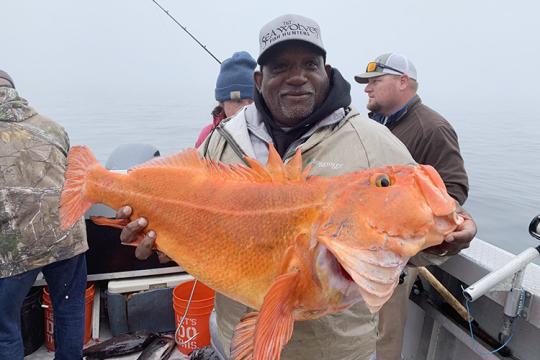
 Mike Acquafredda holding a tray of sea beans. Credit: NOAA Fisheries/Mike Acquafredda
Mike Acquafredda holding a tray of sea beans. Credit: NOAA Fisheries/Mike Acquafredda
Data from Tagged Fish to Help Scientists Enhance Restoration Efforts
 A coho salmon swims up the Sol Duc river on the Olympic Peninsula. Credit: Adobe Stock.
A coho salmon swims up the Sol Duc river on the Olympic Peninsula. Credit: Adobe Stock.
Seafood Facts

Is Atlantic Striped Bass Sustainable?
U.S. wild-caught Atlantic striped bass is a smart seafood choice because it is sustainably managed and responsibly harvested under U.S. regulations.
Availability
Available both frozen and fresh year-round, depending on the area.
Source
U.S. wild-caught from Maine to North Carolina, and farmed.
Taste
Both wild-caught and farmed striped bass have a slightly sweet flavor.
Texture
Firm, with large flakes.
Color
Light-colored meat.
Health Benefits
Striped bass is a good source of low-fat protein and selenium. Consumption advisoriesfor striped bass vary from state to state.
Nutrition Facts
Servings: 1; Serving Weight: 100 g (raw); Calories: 97; Protein: 17.73 g; Total Fat: 2.33 g; Total Saturated Fatty Acids: 0.507 g; Carbohydrate: 0 g; Total Sugars: 0 g; Total Dietary Fiber: 0 g; Cholesterol: 80 mg; Selenium: 36.5 mcg; Sodium: 69 mgMore Information
Atlantic Striped Bass Recipes
Looking for some ways to add striped bass into your rotation? If you need cooking inspiration, browse these recipes for striped bass with lemon-parsley sauce, battered fish, and more!

Last updated by NOAA Fisheries on 03/27/2025
Seafood News
 Celebrate Culinary Arts Month with a sustainable seafood recipe for every month of the year.
Celebrate Culinary Arts Month with a sustainable seafood recipe for every month of the year.
What Your Birth Month Says About Your Next Seafood Recipe
 Fresh-caught taʻape on ice. Credit: Conservation International Hawaiʻi.
Fresh-caught taʻape on ice. Credit: Conservation International Hawaiʻi.
Reducing Waste and Feeding Communities in Hawaiʻi with a Whole Fish Approach
 Chef Tyler Hadfield’s Curried Skate Wings with Tomato-Masala Chutney
Chef Tyler Hadfield’s Curried Skate Wings with Tomato-Masala Chutney
Ring In the New Year With These Crowd-Favorite Seafood Recipes
 NOAA Fisheries, in collaboration with Blue Ocean Mariculture, is conducting a multi-year pilot study to evaluate observational methods and tools for studying Hawaiian monk seal behavior. Courtesy of Blue Ocean Mariculture
NOAA Fisheries, in collaboration with Blue Ocean Mariculture, is conducting a multi-year pilot study to evaluate observational methods and tools for studying Hawaiian monk seal behavior. Courtesy of Blue Ocean Mariculture
AI Meets Aquaculture to Study Hawaiian Monk Seal Interactions With Net Pens
Documents
Biennial Striped Bass Report to Congress, 2023
Biennial Report to Congress on the Progress and Findings of Studies of Striped Bass Populations.
Biennial Striped Bass Report to Congress, 2021
Biennial Report to Congress on the Progress and Findings of Studies of Striped Bass Populations.
Biennial Striped Bass Report to Congress, 2019
Biennial Report to Congress on the Progress and Findings of Studies of Striped Bass Populations
Research
Fisheries Ecology in the Northeast
We study the relationship between marine life and their environment to support sustainable wild and farmed fisheries on the Northeast shelf, creating opportunities and benefits for the economy and ecosystem.
Last updated by NOAA Fisheries on 03/27/2025


